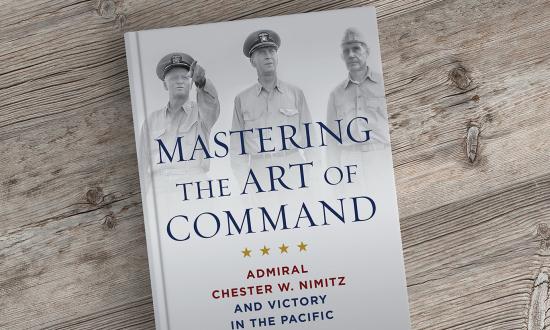American Defense Reform: Lessons from failure and Success in Navy History
By Rear Admiral Dave Oliver, U.S. Navy (Retired), and Anand Toprani. Washington, DC: Georgetown University Press, 2022.
292 pp. Illus. Appx. Index. $34.95.
Reviewed by Lieutenant Commander Steven Wills, U.S. Navy (Retired)
American Defense Reform by retired Rear Admiral Dave Oliver and Dr. Anand Toprani of the U.S. Naval War College is a whirlwind tour of Cold War and immediate, post–Cold War naval history, combined with Admiral Oliver’s personal anecdotes and recommendations for success in defense reform leadership. The intellectual core of the book is centered in a series of case studies of seminal Navy events and leaders during the Cold War and the post–Cold War eras, illustrating lessons learned. The four cases are the 1949 “Revolt of the Admirals” Navy protest of the cancellation of the first supercarrier USS United States; the systems analysis revolution of Defense Secretary Robert S. McNamara in the 1960s; the 1970s viewed through the career of Chief of Naval Operations (CNO) Admiral Elmo Zumwalt Jr.; and the late 1980s/early 1990s end of the Cold War and the term of CNO Admiral Frank Kelso.
The book offers some familiar interpretations of these historical events and leaders from them, as well as some more controversial observations. For example, the authors suggest the Revolt of the Admirals showed the Navy’s poor understanding of the emerging political power of the civilian defense establishment rather than a principled defense of the aircraft carrier as a military unit. The leadership techniques and procedures recommended by the authors in the second half of the book (what is to be done and by whom) certainly stand on their merit, and there are multiple views of major Navy historic events. However, I disagreed with the start of the authors’ historical analysis, which labels the Navy “the most Catholic of services.”
Political scientist Richard Neustadt and historian Ernest May’s book Thinking in Time (Free Press, 1988) is an often-cited reference for American Defense Reform’s historical case studies. Neustadt and May made no claim of firm methodology, but looked for how the cases they examined could have gone better if there was a poor outcome, or how they could be reproduced if successful. They also desired to avoid “rendering verdicts” on individuals or groups, as their goal was to suggest “pointers” on how to do better next time.
The authors of American Defense Reform are tougher historical critics in their case studies in terms of praise or condemnation of individuals and for groups. Defense Secretary James Forrestal, CNO Admiral Arleigh Burke, long-range carrier aviation, and the 1986 Maritime Strategy come in for criticism. The book praises Admiral Zumwalt for his many reforms and gives a relatively balanced assessment of Kennedy and Johnson administration Defense Secretary Robert S. McNamara. The analysis of the failed F-111B carrier-based aircraft is especially good, although McNamara gets off a bit easy for failing to understand the dynamics of carrier aviation.
The reforms of first post–Cold War CNO Admiral Kelso and his staff (OpNav) get high praise for realigning the Navy for the post–Cold War era, but the authors do not note that Kelso’s acquisition reforms, implemented by powerful Navy budget czar/OpNav N8 Admiral Bill Owens, faded after Kelso’s CNO tenure and were entirely changed by CNO Admiral Vern Clark’s early 2000s reorganization of the Navy staff. A closer tie-in with more recent challenges faced by the Navy would have further promoted the book’s message.
The book could have benefited from an index, and some of the footnotes are longer than the text they explain. Overall, American Defense Reform is a bold take on historical events, and readers should draw their own conclusions from its cases and recommendations. That said, the book’s overarching argument that it takes a chorus of clear guidance from civilian leaders and flexibility from uniformed ones to make meaningful defense reform happen is a welcome one.
Dr. Wills is the navalist at the Center for Maritime Strategy (CMS) and a part-time research scientist and the Center for Naval Analyses. He completed a PhD in history at Ohio University in 2017.
Degrade and Destroy: The Inside Story of the War Against the Islamic State, from Barack Obama to Donald Trump
Michael R. Gordon. New York: Farrar, Straus and Giroux, 2022. 496 pp. Notes. Index. $30.
Reviewed by Lieutenant Kyle Cregge, U.S. Navy
Any military officer who has received joint education, or any self-styled military strategist, likely is familiar with the famous Prussian maxim that “war is a continuation of politics by other means.” Carl von Clausewitz’s On War is particularly focused on conflict between states, rather than nonstate actors; and the famous line characterizes how diplomatic struggles between nations devolve into destruction.
It was this thought that continually returned to me while reading Michael R. Gordon’s Degrade and Destroy: The Inside Story of the War against the Islamic State, from Barack Obama to Donald Trump. Gordon’s excellent work covers myriad “dramatis personae” in the historical narrative, gleaned from both his time embedded with numerous military units in the conflict and while reporting on the war with sources up to the highest levels of government. The book will enlighten readers interested in the details of the choices made and the context that informed them. By all accounts, Degrade and Destroy triumphs as an eminently readable work of nonpartisan historical reporting.
Yet, while the narrative never lags, it may prove bitter medicine for the military and policy practitioners who are currently serving. The “politics” that continued via other means in the war against ISIS were international, intergovernmental, interservice, interpersonal, and, above all, internecine. Precisely because it is “the inside story,” readers are privy to the inner workings of the U.S., Iraqi, and Syrian governments creating the conditions for ISIS’s conquest through the Levant. Uniquely challenging is reading about the desired end of the Iraq War in 2011, motivated by domestic political goals that superseded advice by military and intelligence officials, right up until the facts on the ground became too ugly to ignore. Many of the same people directing the evacuation of U.S. troops from Iraq would lead the same effort in the same way in Afghanistan a decade later to similarly sanguinary results.
Gordon credits the war as formalizing doctrine developed by the special operations communities in 2003, which came to be known as the “by, with, and through” strategy, where “operations [against nonstate actors] were carried out against a common foe by a diverse array of local allies, with support from U.S. forces and coalition partners, and through a U.S. legal and diplomatic framework.” No doubt this policy reduced the risk of increased American casualties in Iraq and Syria, while further avoiding the possibility of another quagmire in the Middle East. However, it, too, has trade-offs, from the ability to control the proxy forces fighting for mutual interests, to damaging ally relationships (or helping interstate adversaries) by arming different groups, to the limitations of managing collateral damage despite enormous technological advantages.
Indeed, as much as mapping terrain and personnel helps readers maintain continuity of focus throughout the prelude to and execution of Operation Inherent Resolve, Degrade and Destroy may have benefited from a collection of interest maps, displaying “who wanted what, when.” While it may ultimately have appeared as knotted and unintelligible as the worst slides developed in the Pentagon, charitable readers will readily conclude that U.S. policy-makers were dealt bad, worse, and worst choices.
ISIS alone was a significant problem; it was made worse by Russian and Iranian support for Syria and regional proxies; numerous provincial, ethnic, religious, and intertribal conflicts; Iraqi, Turkish, and Kurdish tensions; and a coalition constantly responding to domestic and international media—and all against the backdrop of a U.S. populace increasingly disinterested with using U.S. lives and dollars to solve Middle Eastern problems. It was a Gordian Knot with no sword to cut it, further hampered by a bureaucracy that appeared so skittish or sclerotic to be a danger to itself, as when the arbitrary width of a red line drawn on a map determines whether an ISIS target is within the rules of engagement.
Ultimately, those interested in the ISIS campaigns and the future of counterterrorism would do well to read this book, and the rest should read it to sober themselves for the challenges to come.
Lieutenant Cregge is a surface warfare officer. He served on a destroyer, cruiser, and aircraft carrier as an air-defense liaison officer. He is the prospective operations officer for the USS Pinckney (DDG-91).
The Air War in Vietnam
Michael E. Weaver. Lubbock, TX: Texas Tech University, 2022. 612 pp. Maps. Illus. Notes. Biblio. Index. $49.95.
Reviewed by Barrett Tillman
Nearly 60 years after the first U.S. bombing missions in Southeast Asia, the literature on the Vietnam air war is immense and growing. In fact, Michael Weaver’s exhaustive Air War in Vietnam shares the title with at least 20 previous and current volumes. However, there the similarities largely end. His narrative—more than 400 pages of small font—likely will be the go-to treatment for years to come.
In addition, the book is meticulously documented with 156 pages of notes plus 40 more with sources and index. Some sources were declassified as late as 2017.
The text is divided into three sections, each with related chapters. The broad subjects are air superiority and national policy; air support and airpower effectiveness; and coercion and interdiction.
While Weaver devotes ample coverage to the air war’s most familiar and most glamorous aspect—air combat against Hanoi’s MiGs—he shines his light on the other players as well. Notable among them are enemy defenses, the “precision revolution,” aerial tankers, reconnaissance, and airlift, plus interdiction and close-air support. He integrates the “in-country” air war in South Vietnam, Laos, and Cambodia within the broader nine-year story—no small accomplishment. The vital role played by helicopters in the South receives deserved coverage.
Weaver describes in detail the varied aspects of Operation Rolling Thunder, the erratic U.S. bombing campaign of 1965–68. Hand-in-glove with the air campaign throughout the war were political restrictions—most notably the onerous rules of engagement, which receive a full chapter to themselves. More than half a century later, survivors of the “conflict” remain bitter about the limits placed on them, which not only reduced effectiveness, but also cost unnecessary losses of friends and aircraft. In that context, Weaver adopts a multitiered approach to his subject, the nuts and bolts of Vietnam airpower (technology, statistics, wins, and losses) in context of achieving U.S. national policy goals. And aye, there’s the rub. President Lyndon B. Johnson had no goal other than “don’t lose,” a miserable substitute for strategy.
Weaver astutely compares the policies and effectiveness of the Johnson administration with Richard Nixon’s. Johnson’s cabal with Secretary of Defense Robert McNamara, Secretary of State Dean Rusk, and others dithered for five years, alternately attempting a carrot-and-stick approach that was bound to fail. Weaver’s description of Hanoi’s leadership is chillingly accurate—hard-eyed zealots with ice water in their veins and a willingness to risk destruction to achieve their ends. As Weaver says, it was “almost a religious pursuit.” Against such resolve, LBJ, the Capitol Hill arm-twister, never stood a chance.
Nixon entered office in 1969 with an overriding goal: end the war on approximately acceptable terms. The public was increasingly weary of weekly casualty reports with no visible progress. Finally, in the spring of 1972, Washington responded to Hanoi’s Easter Offensive into South Vietnam with the full realm of airpower. Operation Linebacker sent the B-52s north, and the U.S. government finally mined Haiphong Harbor and lifted restrictions on strategic targets.
Though Weaver does not address the POW-MIA controversy, that aspect of the war has been thoroughly covered elsewhere.
For so thorough a treatment, there are surprisingly few illustrations—30 black-and-white photos (many familiar to some readers) plus six maps of Southeast Asia and North and South Vietnam.
Weaver’s conclusion is bound to generate discussion. He asserts that well-conducted operations cannot overcome flawed strategy. Therefore, Vietnam represented not a failure of airpower, but a failure of war as practiced by the United States in Southeast Asia.
Mr. Tillman has received two Naval Institute writing awards, and his first Naval Institute book, The Dauntless Dive Bomber, has been in print since 1976. With Stephen Coonts in 2019, he coauthored The Dragon’s Jaw (DaCapo Press), the story of Thanh Hoa Bridge, North Vietnam’s most notorious target.
Into Enemy Waters: A World War II Story of the Demolition Divers Who Became the Navy SEALs
Andrew Dubbins. New York: Diversion Books, 2022. 352 pp. Sources. $28.99.
Reviewed by Commander Chris O’Connor, U.S. Navy
In picking up this book, my goal was to fill a void in my knowledge of naval history. I previously knew very little about the origin of the underwater demolition teams (UDTs, the precursors to the SEALs), and Into Enemy Waters was a fast-paced and very readable introduction.
It is the firsthand account of George Morgan, a sailor from New Jersey who was one of the original “Frogmen,” and his journey from Naval Combat Demolition School in Fort Pierce, Florida (the proto-BUD/S), to demilitarizing explosives in a newly surrendered Japan, with combat on Omaha Beach and other dangerous locales in between.
Peppered with “witness to history” anecdotes, it weaves Morgan’s story into the greater fabric of the development of UDTs. To do so, it includes the account of how Draper Kauffman, the father of UDTs, built the community from scratch and shepherded it through the growing pains of a new organization. The author includes World War II history as a context at the beginning of every chapter, giving it the necessary light touch to set the scene for each episode of the tale.
A fan of Sidewinder (Naval Institute Press, 2013) and Learning War (Naval Institute Press, 2019), I was hoping that this book would provide insight into how the UDTs innovated, and I was not disappointed. Having done research on Navy innovation organizations in the past, I had never heard of JANET, Kauffman’s unit that was tasked with new techniques for underwater obstacle clearance. Even back then, there was experimentation with unmanned systems and what would be later called SCUBA, but the systems were discounted as being too immature to use after testing. The author’s research shows in the 30 pages of listed sources that I plan to leverage to learn more about that unit and its methods.
This book is a quick read, perfect for an airplane ride. The author is a journalist who has written narrative nonfiction for Hollywood, and it shows in his evocative turns of phrase. Having read this as a physical book, I could see how it would make an excellent audiobook.
For me, this was the entrée I needed to this topic, but if you already know about the exploits of Draper Kauffman, what the U.S. Amphibious Gunboat Unit did to earn the Presidential Unit Citation off Iwo Jima, or why the USS Blessman (DE-69) has a special place in UDT history, you might require something more substantial.
Commander O’Connor is currently the strategic plans officer at NATO Supreme Headquarters Allied Powers Europe (SHAPE) and is vice president of CIMSEC.










